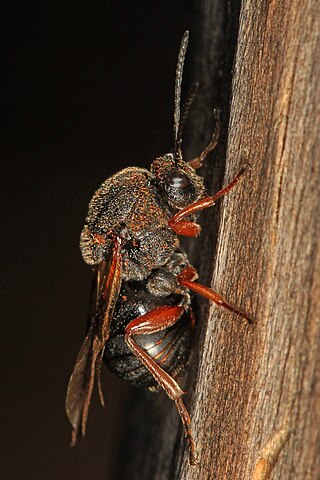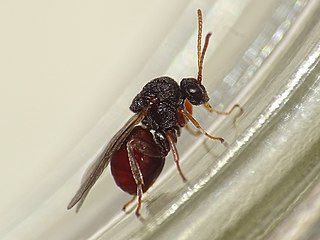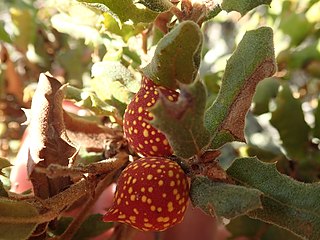
Gall wasps, also traditionally calledgallflies, are hymenopterans of the family Cynipidae in the wasp superfamily Cynipoidea. Their common name comes from the galls they induce on plants for larval development. About 1,300 species of this generally very small creature are known worldwide, with about 360 species of 36 different genera in Europe and some 800 species in North America.

Andricus is a genus of oak gall wasps in the family Cynipidae.

Cynipini is a tribe of gall wasps. These insects induce galls in plants of the beech and oak family, Fagaceae. They are known commonly as the oak gall wasps. It is the largest cynipid tribe, with about 936 to 1000 recognized species, most of which are associated with oaks. The tribe is mainly native to the Holarctic.
Aphelonyx is a genus of oak gall wasps in the family Cynipidae, comprising three known species:

Atrusca is a genus of gall wasps in the family Cynipidae. It consists of approximately 50 species, and is found in North and Central America.
Bassettia is a genus of gall wasps found in North America.
Synergini is a tribe of gall wasps in the subfamily Cynipinae.
Ufo is a genus of gall wasps in the tribe Synergini, first discovered in Japan. Its genus name Ufo comes from the common phrase "unidentified flying object", in this case applied because the researchers did not know what the wasp was when they first saw it.

Amphibolips is an American genus of gall wasps in the family Cynipidae. There are about 57 described species in the genus Amphibolips with several others still undescribed.

Feron kingi, the red cone gall wasp, is a species of gall wasp in the family Cynipidae.

Disholcaspis is a genus of gall wasps in the family Cynipidae. There are more than 40 species described in the genus Disholcaspis. Some Disholcaspis species induce galls that produce honeydew, a sweet liquid that attracts yellow jackets, ants, and bees. These insects then protect the galls from parasitic wasps.

Callirhytis is a genus of gall wasps in the family Cynipidae. There are more than 90 described species in Callirhytis. Wasps in this genus primarily induce wasps on oak trees in North America.

Andricus dimorphus, also called the clustered midrib gall wasp, is a species of oak gall wasp in the family Cynipidae. Galls in which the larvae live and feed are formed in clusters along the midrib on the underside of oak leaves.

Philonix is a genus of oak gall wasps in the family Cynipidae. Species in this genus are only known from Canada, the United States, and Mexico. The larvae of Philonix wasps induce galls on white oaks that are typically spherical, soft and fleshy. Galls are usually formed on the underside of leaves. Adult wasps are similar in appearance to species in the genus Acraspis. Many gall wasps have alternate sexual and asexual generations, but this has not been documented in Philonix.

Amphibolips quercusostensackenii is a species of gall wasp in the family Cynipidae. It is found throughout eastern North America.

Phylloteras is a North American genus of gall wasps in the family Cynipidae, tribe Cynipini .

Burnettweldia is a genus of oak gall wasps in the Nearctic.

Kokkocynips is an American genus of gall wasps in the family Cynipidae. There are about 8 described species in the genus Kokkocynips with several others still undescribed.

Acraspis guadaloupensis is a relatively uncommon species of cynipid wasp that produces galls on intermediate oaks. The intermediate oak disc wasp was first described in 1911 and has been moved between genera more than once. Distribution is limited to California in North America. The flattened galls appear on leaves of Quercus chrysolepis, the canyon live oak.















